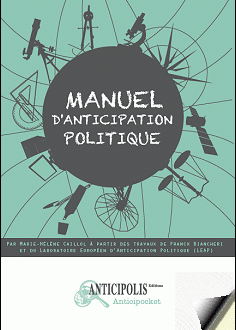For many years now, our European Laboratory of Political Anticipation has been using a method invented by Franck Biancheri: the Political Anticipation Method. The GEAB, our monthly Bulletin is the best example of how this method can be used. This method has been described and explained by our president Marie-Hélène Caillol in a book: A Manual of Political Anticipation, available at Anticipolis Editions. We offer you today an exclusive access to the introduction of the Manual:
On many occasions during the last 25 years, the sphere of influence focused around the personage of Franck Biancheri has, de facto, provided fertile ground for the correct anticipation of major historic events : the fall of the Iron Curtain, the crisis of the European Commission, the collapse of the Dollar and the global systemic crisis… are some of the most striking predictions in this story (which is still unfolding) on that part of this movement whose very diverse features (European context, network organisation, political objectives, independent state of mind…) allows to suppose that they play some role, without doubt, with this « ability ». Indeed, if one correct anticipation is the result of chance, the second can be good luck, but by a third, it becomes possible to hope that some rules and a rational approach are at play.
On the basis of these established facts Franck Biancheri began to forge the expression « political anticipation » in the ‘90s, so giving birth to a new tool in understanding and managing the world, a decision-making tool.
Since the middle of the ‘90s, Europe 2020 has developed a series of political anticipation studies applied, particularly, to the long-term development of the European Union (with 2020 as a horizon). Politics, international relations, sociology, institutions, the economy, finance, languages, education… multidisciplinarity and multi-linguistic characterize all these studies as well as two fundamental principles : use practitioners’ grass-root experience to the fullest extent rather than academic views, and have actual knowledge of the regions and countries involved (which really means knowledge other than of the capitals and elite leaders).
Then, the end of the ‘90s, saw the launch of the European Laboratory of Political Anticipation (LEAP). After many years working for national and European institutions providing forecasting seminars on a variety of European governance problems, LEAP decided in 2006 to give its studies a more general character and launched the GlobalEurope Anticipation Bulletin (GEAB), a monthly assignment in political anticipation carrying high risks in terms of credibility but necessary for understanding the usefulness and relevance of anticipation work. In effect, the wide exposure of the GEAB was the “test by fire” of political anticipation. Would our work stand up to close inspection by millions of people over many years?
Of course, there have been mistakes – in no circumstances should political anticipation be considered as an exact science, but the major trends (global systemic crisis, world geopolitical dislocation…) identified by the LEAP team from January 2006 onwards were verified openly and publicly by a large number of people. Thus, our work, heavily criticised at the beginning, has even forced the respect of academics, giving rise to a need for a contemporary approach, which is the purpose of this manual: What is political anticipation (and what it isn’t)? What is its use? What are the tools, principles and rules which shape it? What are its limits? These are the questions which this small manual will try and answer.
The analysis of the context provided by this European movement in which the story of political anticipation is written, numerous interviews with Franck Biancheri, careful reading of the GlobalEurope Anticipation Bulletin, as well as a series of seminars deliberating on the formalization of a method of anticipation, is the foundation of this publication.


 LEAP2040 Toutes les informations et archives Europe2040
LEAP2040 Toutes les informations et archives Europe2040



